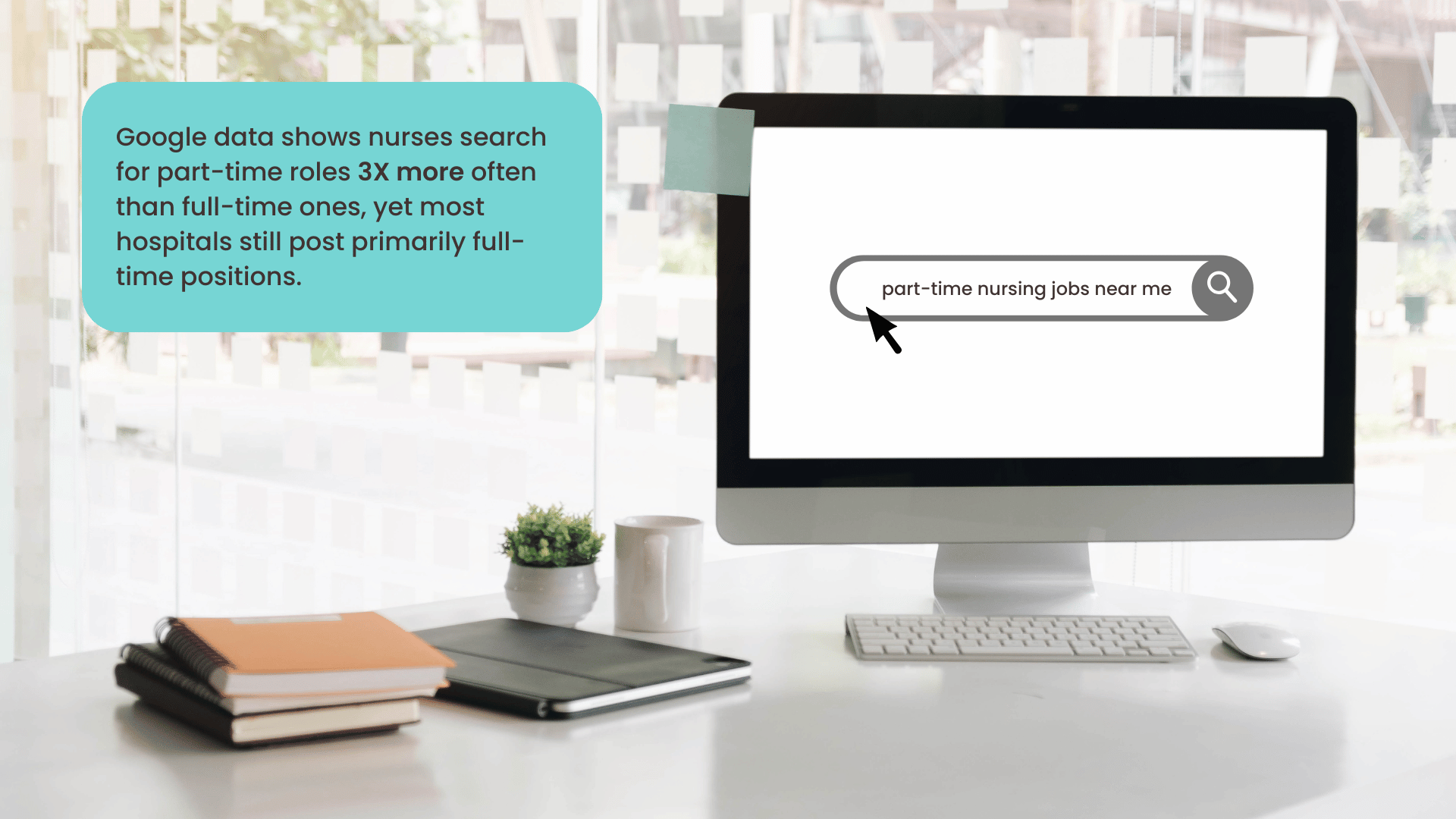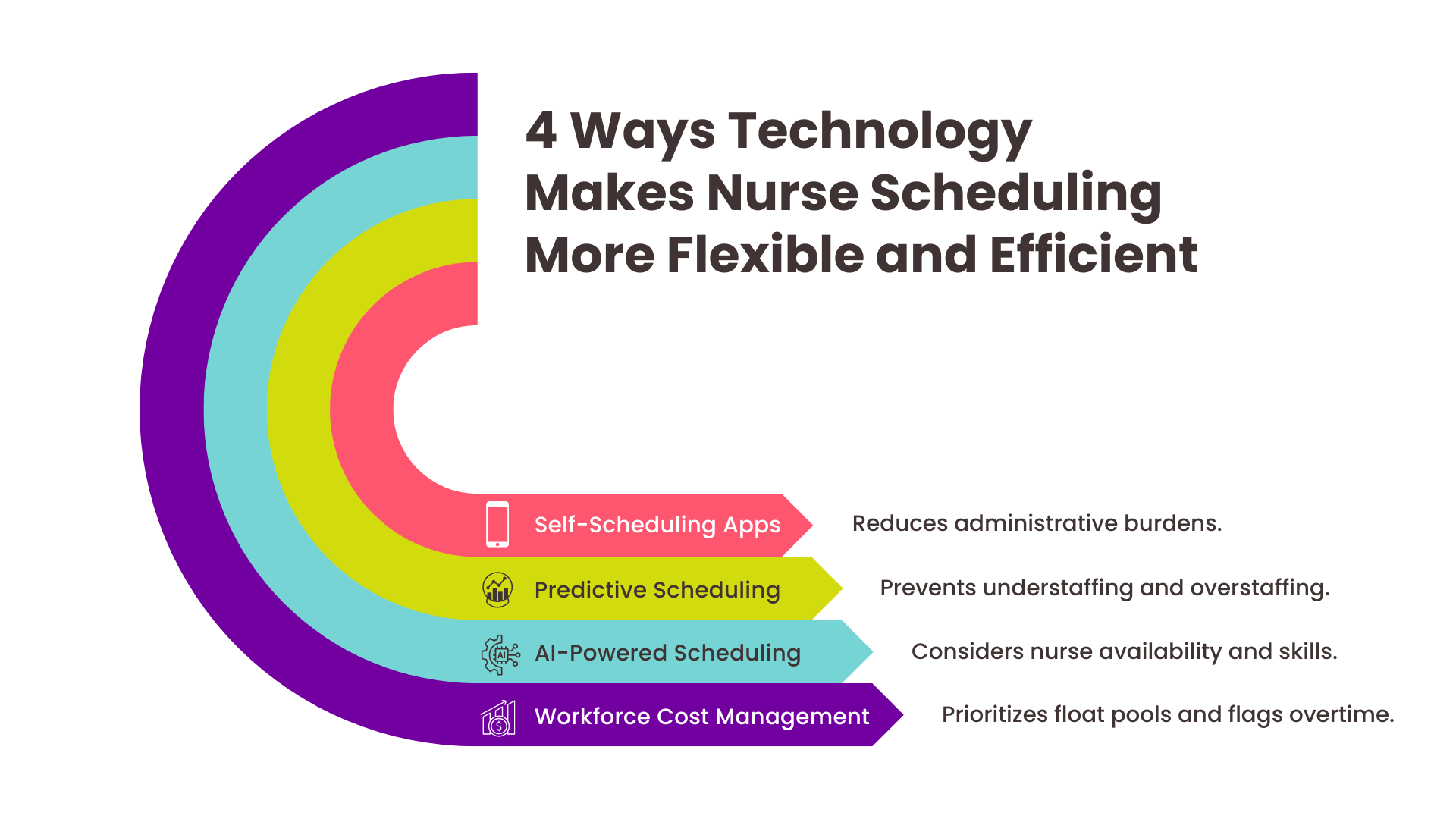Why Health Systems Need Flexible Scheduling for Nurses

Struggling with nurse turnover, costly overtime, or gaps in patient care? The solution may be simpler than you think: flexible scheduling for nurses. Health systems that give nurses more control over their shifts see higher retention, smoother operations, and better patient outcomes, proving flexibility is more than a perk, it’s a bold workforce strategy.
Rising Demand for Flexible Nurse Schedules
Today’s nurses value flexibility. Many have multiple income streams or personal interests, so they don’t all want full-time jobs. In fact, Google data shows nurses search for part-time roles three times more than full-time ones.
Hospitals can attract and retain more clinicians by offering flexible schedules—like 4, 8, or 20 shifts a month—so nurses can work on their terms. While pay matters, giving clinicians control over when and how much they work is just as crucial for engagement.
According to Kelley Strandberg, vice president of nursing and workforce innovation at ShiftMed, today’s healthcare workforce demands choice. “Nurses expect schedules that support their work-life balance and career goals. They’re telling their organizations what they need to thrive, and in return, health systems that provide that choice will see higher engagement, stronger retention, and better overall performance.”
Recognizing flexible nurse scheduling as a key driver of future success, many leading health systems are turning to tech-driven solutions, such as self-scheduling apps, to make it a reality. Before exploring how technology drives workforce flexibility, it’s essential to recognize why flexibility is key to keeping your health system competitive, efficient, and adaptable for the long term.

3 Benefits of Flexible Scheduling for Nurses
Traditional nurse scheduling adds complexity to health system workforce management, as short staffing and nurse burnout drive high turnover while manual scheduling increases operational costs and administrative burden. Here are three ways flexible scheduling solves those challenges:
1. Higher Nurse Retention
Flexible scheduling supports work-life balance, allowing nurses to manage personal and professional commitments while boosting overall job satisfaction. Research shows that nurses with scheduling flexibility are significantly less likely to leave their positions, helping health systems reduce recruitment and training costs and maintain a stable, engaged workforce. At the same time, offering this flexibility makes your health system more attractive in a competitive job market, making recruiting and retaining experienced nurses easier.
2. Increased Operational Efficiency
Flexible scheduling allows your health system to align nurse availability with patient demand, minimizing understaffed or overstaffed shifts and reducing costly last-minute overtime. Technology-enabled scheduling platforms, such as ShiftMed, take this further by factoring in nurse preferences, skills, and peak patient times to optimize coverage efficiently. This approach also provides the flexibility needed to respond quickly to unexpected events—like surges in patient volume or staff absences—ensuring consistent, high-quality care.
3. Better Patient Care
Flexible scheduling ensures shifts are properly staffed, maintaining high-quality care while reducing errors, wait times, and nurse fatigue. Giving nurses more control over their schedules also boosts engagement and attentiveness, leading to better patient outcomes. By reducing turnover, flexible scheduling also helps patients receive care from experienced, familiar staff, supporting continuity, safety, and overall satisfaction.

4 Ways Technology Makes Nurse Scheduling Flexible and Efficient
Nurse scheduling is inherently complex, requiring a balance between staffing levels and real-time patient demand. The right workforce management technology can turn this scheduling complexity into a streamlined, efficient process that ensures optimal coverage, reduces administrative burden, and supports better outcomes for staff and patients. Here are four ways technology enables flexible nurse scheduling in practice:
1. Self-Scheduling Apps
Self-scheduling apps simplify flexible nurse scheduling by letting nurses choose or swap shifts based on their availability and preferences. Managers maintain oversight to ensure coverage. By automating scheduling and tracking staffing in real time, these tools reduce administrative burden, improve nurse satisfaction, and optimize operations without compromising patient care.
2. Predictive Scheduling
Workforce management technology can analyze historical staffing data, patient trends, and real-time census volumes to forecast staffing needs days or weeks ahead. This predictive insight reduces last-minute shift scrambles, prevents understaffing or overstaffing, and empowers nurses with more control over their schedules. Technology makes flexible scheduling possible and practical by proactively aligning staffing with patient demand.
3. AI-Powered Shift Scheduling
Filling shifts—particularly in high-acuity units like the ICU—is often complex and time-consuming for unit managers. AI-powered scheduling simplifies this process by considering nurse availability, skills, and preferences, making it easier to offer flexible scheduling options. The result is a win-win, with nurses gaining more control and flexibility over their schedules and health systems maintaining oversight and ensuring proper coverage.
4. Cost Management
Workforce management technology can help health systems achieve flexible nurse scheduling while controlling labor costs. By prioritizing nurse float pools, flagging overtime, and streamlining schedules, facilities can match the right staff to the right shift. As a result, nurses enjoy greater scheduling flexibility and health systems achieve optimized labor spending and high-quality patient care.
5 Implementation Strategies for Flexible Nurse Scheduling
Implementing flexible nurse scheduling doesn’t have to be complex or costly. The right approach can strengthen your team, increase resilience, and improve patient outcomes. Here are five steps for implementing flexible scheduling into your health system effectively:
1. Assess Workforce Needs and Preferences
Begin by getting a clear picture of your nursing team’s needs. Use surveys or focus groups to learn about their preferred shift lengths, days off, and overall scheduling flexibility. At the same time, look closely at patient volume patterns, unit-specific staffing demands, and seasonal fluctuations. This dual approach ensures your schedule supports your staff and high-quality patient care.
2. Define Flexible Scheduling Models
The International Council of Nurses defines flexible work as “employer-employee work arrangements structured to accommodate organizational and individual needs.” In practice, flexibility looks different for every nurse, especially in a workforce that spans multiple generations—each with unique priorities, life stages, and work preferences.
That’s why health systems need to define flexibility for their organization and offer real options. Providing a variety of scheduling choices—such as self-scheduling, part-time shifts, or per diem opportunities—lets nurses work in ways that fit their lives. This approach not only boosts satisfaction and retention but also helps your organization operate more efficiently, all while maintaining high-quality patient care.
3. Leverage Workforce Technology
Flexible scheduling becomes much more manageable when supported by the right technology. Mobile apps and AI-driven healthcare workforce management platforms can optimize shift coverage based on demand forecasts, allow nurses to swap or pick up shifts with minimal administrative effort, and ensure compliance with labor laws, union agreements, and patient-to-nurse ratios. By investing in these tools, health systems save time, reduce administrative burden, and make it easier for staff to embrace flexible scheduling, improving overall adoption and satisfaction.
4. Engage Nursing Staff in the Transition
Successful implementation starts with involving nurses at every step. Engaging staff early builds buy-in, reduces resistance, and ensures the changes truly meet their needs. Share the benefits of flexible scheduling, gather feedback regularly, and let nurses try out new scheduling tools before a full rollout. Visible support from leadership is critical—when executives champion the initiative, it signals that flexibility is a priority for the organization.
5. Train Nurse Managers and Staff
Flexible scheduling moves some decision-making into the hands of managers and staff, which makes proper training essential. Equip your team to use scheduling software efficiently, understand the rules and constraints—such as labor regulations and coverage requirements—and manage requests, shift swaps, and coverage gaps proactively. Providing ongoing support helps ensure a smooth rollout, reduces errors, and keeps both staff and patient care running seamlessly.
Download our strategic nursing plan template for a clear, actionable blueprint to build a flexible, high-performing nursing workforce that's ready for today’s challenges and tomorrow’s demands.
Compliance Considerations for Flexible Nurse Schedules
When implementing flexible nurse scheduling, it’s essential to stay mindful of labor laws, union agreements, and patient-to-nurse ratio requirements. Health systems need to ensure that part-time, self-scheduled, or per diem options don’t compromise compliance or coverage. The key is balancing flexibility with oversight—using clear policies and technology to track schedules, maintain staffing ratios, and adapt quickly to changing patient needs. By doing so, organizations can offer nurses the flexibility they want while keeping operations smooth and compliant.
Flexible Nurse Scheduling FAQs
Q: Why is flexible scheduling important for nurses?
A: Flexible scheduling helps nurses balance work and personal life by offering part-time, per diem, or variable shifts. Health systems that provide flexibility can attract and retain top nursing talent while improving overall job satisfaction.
Q: How does flexible scheduling benefit hospitals?
A: Offering flexible schedules helps health systems fill more shifts, reduce overtime costs, and improve nurse retention. It also allows systems to tap into a larger, more diverse workforce.
Q: Does flexible scheduling affect patient care?
A: With proper workforce management, flexible scheduling maintains safe nurse-to-patient ratios, ensuring high-quality care while giving nurses more control over their schedules.
Q: What technology supports flexible nurse scheduling?
A: Workforce management software enables health systems to post shifts, match nurses to open shifts, and approve schedules efficiently. Technology ensures coverage, reduces scheduling conflicts, and supports nurse engagement.
Q: How can health systems start implementing flexible scheduling?
A: Begin by offering part-time or variable shifts in one department. Collect feedback, optimize scheduling processes, and expand system-wide with the support of scheduling technology.

UNC Health: Improving Coverage Through Flexible Nurse Scheduling
UNC Health, based in Chapel Hill, North Carolina, faced challenges with low participation in its float pool across outpatient clinics, leading to staffing shortages, added pressure on full-time staff, and potential impacts on care quality. That changed with the adoption of ShiftMed Flex, a platform that gives float nurses 24/7 access to available shifts across the UNC system. By empowering nurses with greater flexibility and control over their schedules, UNC Health increased engagement, improved coverage, and reduced strain on staff.
ShiftMed Supports Flexible Scheduling for Nurses
ShiftMed addresses the barriers to implementing flexible nurse scheduling by providing a unified, technology-driven platform that works across your health system. The platform allows health systems to standardize scheduling while accommodating the unique needs of each unit and nurse. With features like self-scheduling and AI-powered staffing predictions, ShiftMed makes it easier to offer flexibility without compromising coverage or patient care.
Schedule a free workforce consultation today to learn more.